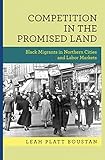Competition in the Promised Land : Black Migrants in Northern Cities and Labor Markets / Leah Platt Boustan.
Material type: TextSeries: National Bureau of Economic Research Publications ; 39Publisher: Princeton, NJ : Princeton University Press, [2016]Copyright date: ©2017Description: 1 online resource (216 p.) : 15 line illus. 14 tablesContent type:
TextSeries: National Bureau of Economic Research Publications ; 39Publisher: Princeton, NJ : Princeton University Press, [2016]Copyright date: ©2017Description: 1 online resource (216 p.) : 15 line illus. 14 tablesContent type: - 9780691150871
- 9781400882977
- African Americans -- Economic conditions -- 20th century
- African Americans -- Migrations -- History -- 20th century
- African Americans -- Social conditions -- 20th century
- African Americans; Economic conditions, 20th century
- African Americans; Migrations; History, 20th century
- African Americans; Social conditions, 20th century
- Migration, Internal -- United States -- History -- 20th century
- Migration, Internal; United States; History, 20th century
- Rural-urban migration -- United States -- History -- 20th century
- Rural-urban migration; United States; History, 20th century
- BUSINESS & ECONOMICS / Economic History
- American society
- Civil War
- Great Black Migration
- Latin America
- World War I
- birth cohorts
- black arrivals
- black community
- black economic growth
- black economy
- black in-migration
- black migrants
- black migration
- black residents
- black southerner mobility
- black workers
- earnings convergence
- earnings growth
- earnings penalty
- economic advancement
- employment
- family backgrounds
- fiscal changes
- housing prices
- industrial cities
- industrial jobs
- labor market competition
- labor markets
- market discrimination
- new migration wave
- northern employers
- northern factories
- northern housing markets
- northern labor
- political changes
- pre-market discrimination
- property tax rates
- public goods
- southern blacks
- suburban units
- suburbanization
- wage losses
- white departures
- white flight
- white relocation
- white-collar workers
- young migrants
- 305.896073 23
- E185.6 .B77 2018
- online - DeGruyter
- Issued also in print.
| Item type | Current library | Call number | URL | Status | Notes | Barcode | |
|---|---|---|---|---|---|---|---|
 eBook
eBook
|
Biblioteca "Angelicum" Pont. Univ. S.Tommaso d'Aquino Nuvola online | online - DeGruyter (Browse shelf(Opens below)) | Online access | Not for loan (Accesso limitato) | Accesso per gli utenti autorizzati / Access for authorized users | (dgr)9781400882977 |
Browsing Biblioteca "Angelicum" Pont. Univ. S.Tommaso d'Aquino shelves, Shelving location: Nuvola online Close shelf browser (Hides shelf browser)

|

|

|

|

|

|

|
||
| online - DeGruyter Early Auden, Later Auden : A Critical Biography / | online - DeGruyter A Matter of Interpretation : Federal Courts and the Law - New Edition / | online - DeGruyter Aristotle's Politics : Writings from the Complete Works: Politics, Economics, Constitution of Athens / | online - DeGruyter Competition in the Promised Land : Black Migrants in Northern Cities and Labor Markets / | online - DeGruyter Dictators and Democrats : Masses, Elites, and Regime Change / | online - DeGruyter Democracy's Infrastructure : Techno-Politics and Protest after Apartheid / | online - DeGruyter Everyday Sectarianism in Urban Lebanon : Infrastructures, Public Services, and Power / |
Frontmatter -- Contents -- Acknowledgments -- Introduction -- Chapter 1: Black Migration from the South in Historical Context -- Chapter 2: Who Left the South and How Did They Fare? -- Chapter 3: Competition in Northern Labor Markets -- Chapter 4: Black Migration, White Flight -- Chapter 5: Motivations for White Flight: The Role of Fiscal/Political Interactions -- Epilogue: Black Migration, Northern Cities, and Labor Markets after 1970 -- References -- Index
restricted access online access with authorization star
http://purl.org/coar/access_right/c_16ec
From 1940 to 1970, nearly four million black migrants left the American rural South to settle in the industrial cities of the North and West. Competition in the Promised Land provides a comprehensive account of the long-lasting effects of the influx of black workers on labor markets and urban space in receiving areas.Traditionally, the Great Black Migration has been lauded as a path to general black economic progress. Leah Boustan challenges this view, arguing instead that the migration produced winners and losers within the black community. Boustan shows that migrants themselves gained tremendously, more than doubling their earnings by moving North. But these new arrivals competed with existing black workers, limiting black-white wage convergence in Northern labor markets and slowing black economic growth. Furthermore, many white households responded to the black migration by relocating to the suburbs. White flight was motivated not only by neighborhood racial change but also by the desire on the part of white residents to avoid participating in the local public services and fiscal obligations of increasingly diverse cities.Employing historical census data and state-of-the-art econometric methods, Competition in the Promised Land revises our understanding of the Great Black Migration and its role in the transformation of American society.
Issued also in print.
Mode of access: Internet via World Wide Web.
In English.
Description based on online resource; title from PDF title page (publisher's Web site, viewed 30. Aug 2021)


